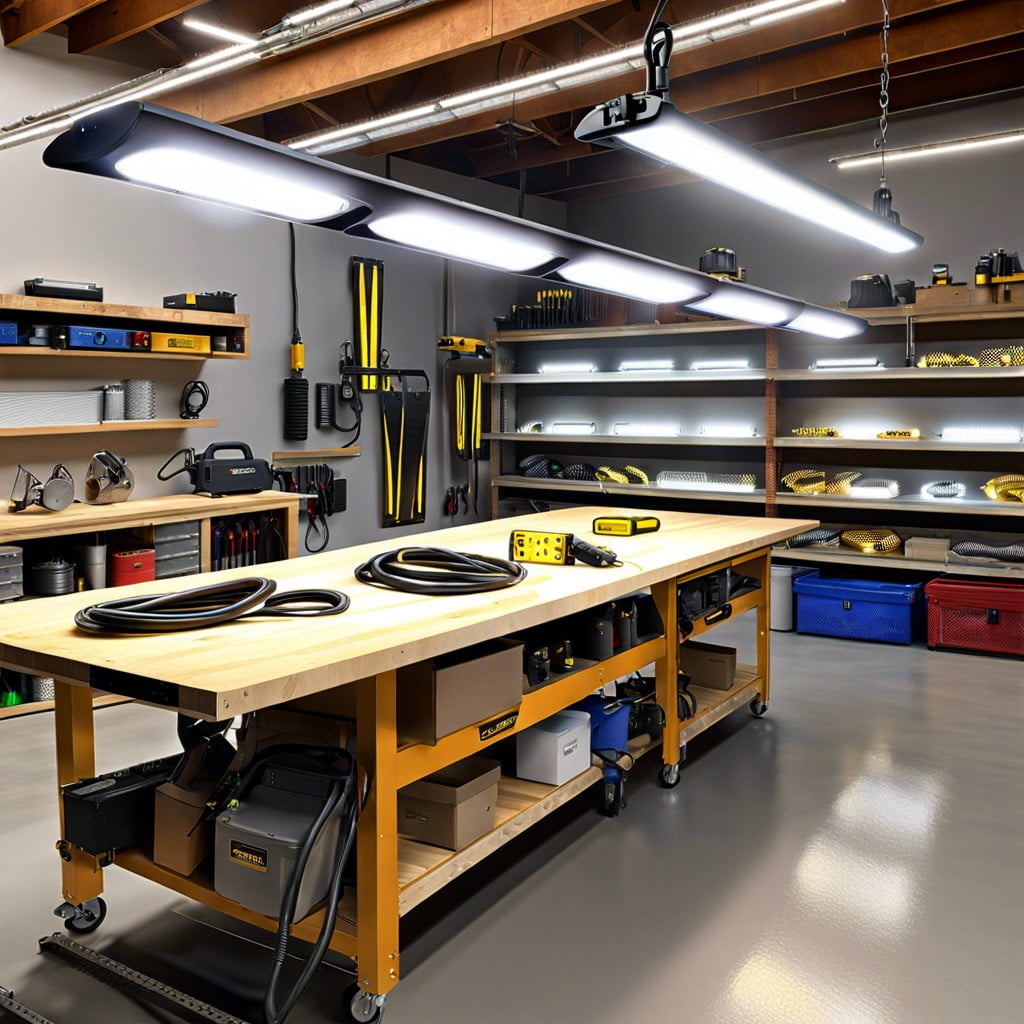Discover how to choose the best shop lights to brighten your workspace effectively.
Key takeaways:
- LED shop lighting fixtures: Integrated, strip, high bay, wraparound
- LED vs. fluorescent lights: Energy consumption, longevity, brightness, disposal
- Installation guidelines for LED shop lights: Turn off power, measure and mark, secure brackets, connect fixtures
- Energy efficiency of LED shop lights: Lower electricity bills, minimal heat waste, long lifespan
- Features to consider when choosing LED shop lights: Brightness, wattage, color temperature, lifespan, ease of installation
Types of LED Shop Lighting Fixtures

LED shop lighting fixtures come in several styles, each suited to different needs and spaces. The most common are:
– Integrated LED fixtures: These have built-in LEDs, so no additional bulbs are needed. They are sleek, produce consistent light, and are long-lasting.
– LED strip lights: Ideal for illuminating long areas like workbenches, these are flexible and can be mounted directly on surfaces.
– High bay LED lights: Designed for high ceilings, these lights provide bright, wide-spread illumination, perfect for large workshops or warehouses.
– LED wraparound lights: These encase the light source in a diffused cover, reducing glare and evenly dispersing light, suitable for general area lighting.
Each type offers different benefits, depending on the specific requirements of your workspace. Consider factors like ceiling height, area size, and task specificity when choosing the right LED shop lighting.
Comparison of LED Shop Lights and Traditional Fluorescent Lights
LED shop lights are quickly becoming the go-to choice, leaving traditional fluorescent lights in the dust. Let’s break down why:
**Energy Consumption**: LED lights consume significantly less power than fluorescents. This means lower electricity bills and reduced environmental impact.
**Longevity**: LEDs shine in terms of durability. They often last up to 50,000 hours, compared to about 30,000 hours for the best fluorescent tubes.
**Brightness and Quality**: LEDs provide bright, high-quality light that flickers less and doesn’t hum. They start instantly, even in cold weather.
**Disposal and Safety**: LEDs contain no mercury, making them safer to handle and easier to dispose of compared to fluorescents, which must be carefully recycled due to their toxic mercury content.
Switching to LEDs can be a bright decision for both your workspace and your wallet.
Installation Guidelines for LED Shop Lights
Before starting your installation, ensure the power is turned off to prevent any electrical mishaps. Depending on the kit you’ve purchased, you might have all necessary mounting hardware included. If not, a quick trip to your local hardware store should do the trick.
Start by measuring your space. Decide where the lights will be most effective—typically, LEDs perform best when evenly spaced across the ceiling. Mark the spots where you plan to hang each fixture.
Use a drill to secure the mounting brackets at the marked locations. It’s crucial that these are firmly attached to the ceiling to support the weight of the lights. Hook the lights onto the brackets, then connect each fixture to the power source following the manufacturer’s wiring guide.
Finally, switch the power back on and test your fixtures to bask in the bright, efficient light of your new LED shop lights. Always double-check your setup for any loose connections or potential hazards. A successful installation not only illuminates your workspace but also enhances safety.
Energy Efficiency of LED Shop Lights
LED shop lights are a game-changer for reducing electricity bills. They consume significantly less power than their fluorescent counterparts—usually around 50-80% less. This drastic drop in energy use results directly from LEDs’ ability to convert electricity into light more efficiently, with minimal heat waste. Moreover, the long lifespan of LED bulbs, which often outlast fluorescent bulbs by thousands of hours, lowers maintenance costs and the frequency of replacements. As a bonus, their optimal performance isn’t influenced by temperature fluctuations, making them ideal for varied shop environments. These factors contribute to a greener, more cost-effective lighting solution in professional spaces.
Features to Consider When Choosing LED Shop Lights
When selecting LED lights for your shop, brightness, expressed in lumens, is key. The larger the space, the more lumens you’ll need. Wattage indicates energy usage, vital for managing power bills. Look for options with adjustable brightness to match various tasks and times of day.
Color temperature affects how the light feels. Cooler temperatures (around 5000 Kelvin) resemble daylight, boosting alertness and productivity. Warmer tones might be more suitable for areas requiring a cozy, less clinical atmosphere.
Consider also the life span of the lights. LEDs boasting longer operational hours reduce replacement frequency— an important cost-saving aspect. Some models come with warranties that offer peace of mind regarding durability and performance.
Lastly, ease of installation matters. Lights that provide multiple mounting options or plug-and-play features simplify setup, letting you brighten your workspace without needing a professional’s help.




